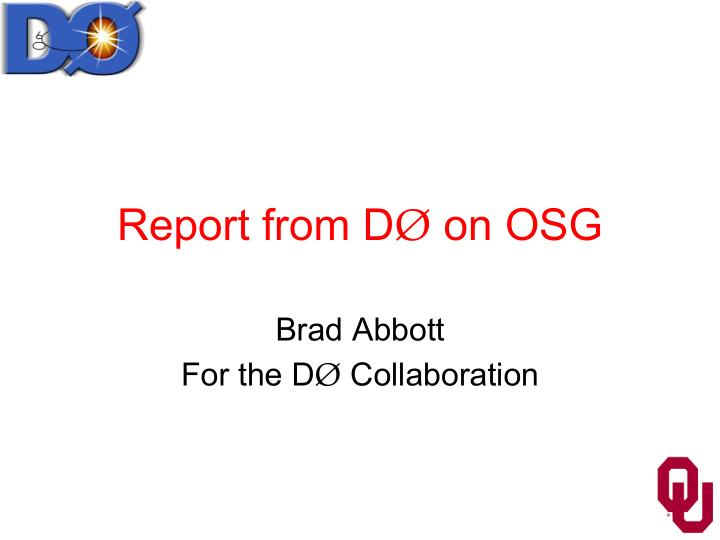



Report from D Ø on OSG Brad Abbott For the D Ø Collaboration
Past use of OSG • Used for analysis in Top quark mass (300,000 CPU hours) • Previously used minimally for MC generation • First big use came from reprocessing of data in 2007. – It is completely finished. – Could not have been done without OSG resources (Thank you). – D Ø learned a lot about using OSG
Daily production during reprocessing
Current use of OSG • Three main areas now D Ø using OSG • MC – Significant MC now being generated using OSG. – Reaching record levels of production, primarily due to OSG. – Now using a larger pool of resources. Good since we do not need to rely on only a few sites.
Current use of OSG • Analysis. • Earlier use was a very simple fortran code which use flat files for input/output. • Now learning how to run “standard” D Ø code on OSG so people can run analysis on OSG. Access to data/ databases etc. • Running standard code has been proven to work by an individual • Not yet a standard practice for analysis • Partly because D Ø has significant resources in our CAB system and average analyzer does not want to invest time to learn how to use at this time. • Continuing to develop code/experience so in future using OSG for analysis is a real option • Still under development stage and not yet in “production”
Current use of OSG • Primary processing • Current farm works well, but some of the code it uses is no longer being supported. • Have 200 nodes setup on OSG on our CAB system for primary production through OSG. Use much of the infrastructure used for reprocessing. • This has been very slow. Still not up and running in production mode after more than 2 months of effort. • Myriad of issues. Getting certificates, having CAB nodes setup properly, having all daemons, code running properly on all nodes, disk space,hard coded time limits etc. • Now very close to running. Critical D0 gets this up and running soon. Behind in data processing by ~ 5 weeks. When OSG up and running, we will ~ double our resources. This will allow us to “catch up” in ~ 2-3 weeks. D Ø currently in a shutdown so not collecting data so both old farm and new OSG resources can be used. • After it is proven that OSG can keep up with incoming data rates, will take down old farm and move to OSG so all of D Ø primary processing will be done on OSG. • This should hopefully occur by the end of the shutdown which is Mid October
Current issues • Asked experts on MC/analysis/Processing what are the current issues with OSG • Resource selector integrated and has been used, but not fully tested. Used minimally during reprocessing but only for 2 sites so did not stress test it. • Pre-emption. Very inefficient for MC production. Causes a number of problems. Code is not setup for pre- emption. Can cause duplicate events, duplicate files etc. Lack of manpower so doubtful D Ø will modify code to deal with pre-emption. Currently we just do not use sites that have pre-emption. Loss of potential resources
Current Issues • The biggest single issue that all experts commented on was Monitoring. • All liked Mona Lisa and are very unhappy with it being deprecated. All claim current monitoring tools not sufficient for production monitoring. • Especially true for primary processing of data. • Even Mona Lisa was not completely satisfactory for primary processing work. Time consuming trying to determine why a job failed, understanding log files is not trivial, finding exactly where/why job failed can be time consuming.
Conclusions • D Ø is using OSG much more and will continue to develop its code to continue to use OSG resources in the future. • Since using OSG for primary processing of data, D Ø will continue to use OSG for many years in the future. • Only major issue for continued efficient use of OSG is monitoring.
Recommend
More recommend